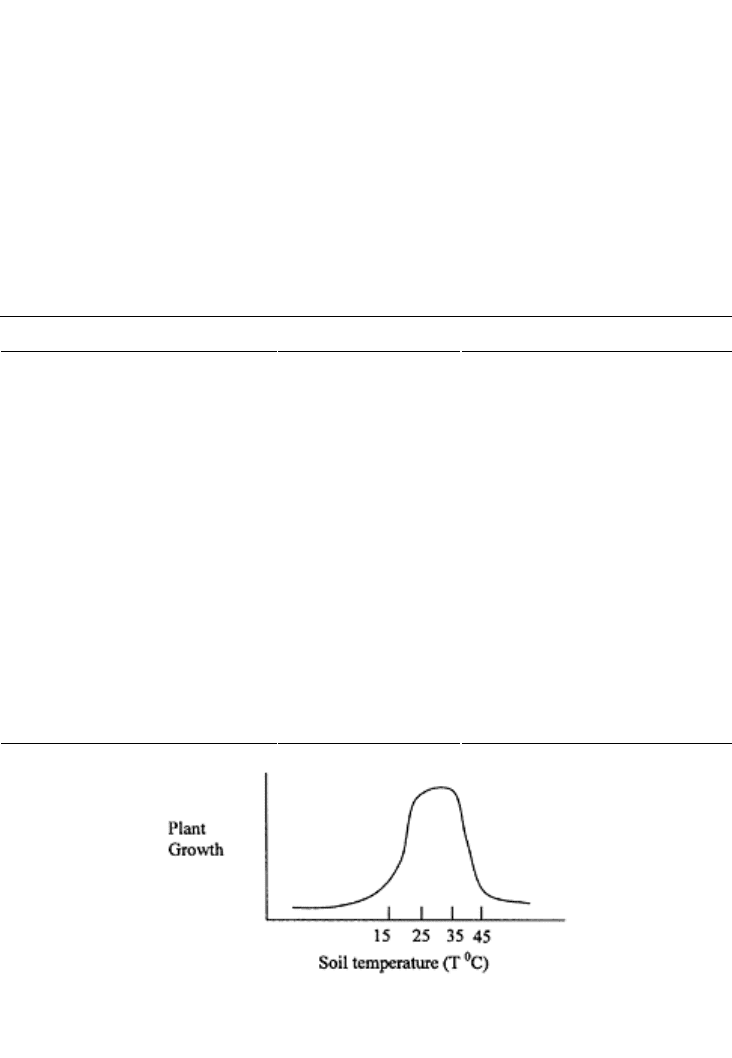Lal R., Shukla M.K. Principles of Soil Physics
Подождите немного. Документ загружается.


Toride N., F.K.Leij, and M.Th.van Genuchten (1993). A comprehensive set of analytical solutions
for nonequilibrium solute transport with first-order and zero-order production. Water Resour.
Res. 29(7):2167–2182.
Valocchi, A.J. (1985). Validity of local equilibrium assumption for modeling sorbing solute
transport through homogeneous soils. Water Resour. Res. 21: 808–820.
Van de Pol R.M., P.J.Wierenga, and D.R.Nielsen (1977). Solute movement in field soil. Soil Sci.
Soc. Am. J. 41:10–13.
van Genuchten M.Th. (1985). A general approach for modeling solute transport in structured soils.
Proc. 17 The Int. Congress. IAH, Hydrogeology of Rocks of Low Permeability. Jan 7–12, 1985,
Tucson, AZ. Mem. Int. Assoc. Hydrogeol. 17:512–526.
van Genuchten M.Th. and F.N.Dalton (1986). Models for simulating salt movement in aggregated
field soils. Geoderma. 38:165–183.
van Genuchten M.Th. and P.J.Wierenga (1976). Mass transfer studies in sorbing porous media I
Analytical solutions. SSSA Proceedings 40(4):473–480.
van Genuchten M.Th. (1981). Non-equilibrium transport parameters from miscible displacement
experiments. Research report 119, USD A, US Soil salinity lab Riverside, California,
van Genuchten M.Th. and J.C.Parker (1984). Boundary conditions for displacement experiments
through short laboratory soil columns. Soil Sci. Soc. Am. J. 48: 703–708.
van Genuchten M.Th. and P.J.Wierenga (1977). Mass transfer studies in sorbing porous media. II.
Experimental evaluation with tritium (
3
H
2
O). Soil Sci. Soc. Am. J. 41:272–277.
van Genuchten M.Th. and P.J.Wierenga (1986). Solute dispersion coefficients and retardation
factors. In: A. Klute, (ed.), Methods of Soil Analysis, Part 1: Physical and Mineralogical
Methods, 2nd Edition, American Society of Agronomy, Madison, Wisconsin.
van Genuchten M.Th. and W.J.Alves (1982). Analytical solutions of the onedimensional
connective dispersion solute transport equation. USDA Tech. Bull. 1661.
Van Wesenbeck I.J. and R.G.Kachanowski (1991). Spatial scale dependence of in situ solute
transport. Soil Sci. Soc. Am. J. 55:3–7.
White R.E., L.K.Heng, and R.B.Edis (1998). Transfer function approaches to modeling solute
transport in soils. In: H.M. Selim and L. Ma (eds.), Physical nonequilibrium in soils. Ann Arbor
Press, Michigan, p 311–346.
White R.E., J.S.Dyson, Z.Gerstl, and B.Yaron (1986). Leaching of herbicides through undisturbed
cores of a structured clay soil. Soil Sci. Soc. Am. J. 50: 277–283.
Wilson J.L. and L.W.Gelhar (1974). Dispersive mixing in a partially saturated porous medium,
Persons Laboratory Report 191, Massachusetts Institute of Technology, Cambridge.
Wilson G.V., H.M.Selim, and J.H.Dane (2000). Flow and transport processes. In: H.D. Scott, (ed.),
Water and Chemical Transport in Soils of the Southeastern USA. SCSB-395. Department of
Plant and Soil Sciences, Oklahama State University.
Principles of soil physics 474

17
Soil Temperature and Heat Flow in Soil
17.1 TEMPERATURE
Temperature is a measure of the thermal state of a body with respect to its ability to
transfer heat. It is also defined as the measure of intensity or potential energy or heat.
Temperature is the driving force for heat flow as pressure head is for water flow.
Temperature is measured in three scales: Celsius (°C), Fahrenheit (°F), and Kelvin (K).
The conversion from one scale to another is given in Table 17.1.
17.2 THE DEVELOPMENT OF THERMOMETER AND
TEMPERATURE SCALES
One of the first attempts to make a standard temperature scale occurred about 170 AD,
when Galen proposed a standard neutral temperature made up of equal quantities of
boiling water and ice with four degrees of heat and cold on either side of this
temperature, respectively. The earliest device used to measure the temperature was
known as a “thermoscope” and consisted of a glass bulb having a long tube, which
extended downward into a container of colored water. Before filling the liquid, some of
the air in the bulb was
TABLE 17.1 Mathematical Expressions and
Relations for Temperature Scales
Temperature scales Mathematical formula
Celsius (°C) °C=(5/9)*(°F−32)
Fahrenheit (°F) °F=(9/5)*°C+32
Kelvin (K) K=°C+273.15
removed, causing the liquid to rise into the tube. As the remaining air in the bulb was
heated or cooled, the level of the liquid in the tube would vary reflecting the change in

the air temperature. An engraved scale on the tube allowed for a quantitative measure of
the temperature fluctuations.
The first sealed thermometer using liquid rather than air as the thermometric medium
was developed for Ferdinand II in 1641. The thermometer was a sealed alcohol-in-glass
device, with 50 “degree” marks on its stem, but no “fixed point” was used to zero the
scale. This device was referred to as a “spirit” thermometer. Robert Hook (1664) used a
red dye in the alcohol and the scale needed only one fixed point, for which every degree
represented an equal increment of volume equivalent to about 1/500 part of the volume of
the thermometer liquid, which was the freezing point of water. Hook demonstrated that a
standard scale could be established for thermometers of a variety of sizes. Hook’s
original thermometer was known as the standard of Gresham College, and was used by
the Royal Society until 1709.
Ole Roemer of Copenhagen, Denmark, developed the thermometer scale in 1702
based upon two fixed points: snow (or crushed ice) and the boiling point of water, and
recorded the daily temperatures at Copenhagen in 1708 and 1709. Gabriel Fahrenheit, an
instrument maker in Amsterdam, The Netherlands, was the first to use mercury as the
thermometric liquid in 1724. Mercury’s thermal expansion is large and uniform, and does
not stick to the glass, and remains a liquid over a wide range of temperatures. The silvery
appearance also makes it easy to read. Fahrenheit measured the boiling and freezing
points of water to be 212 and 32, respectively, and designated temperatures in degrees
Fahrenheit (°F).
In 1745, Carolus Linnaeus of Uppsala, Sweden, described the freezing point of water
as zero, and the boiling point as 100, making it a “centigrade” (one hundred steps) scale.
Anders Celsius (1701–1744) used the reverse scale in which 100 represented the freezing
point and zero the boiling point of water, still, with 100 degrees between the two defining
points. In 1948 use of the centigrade scale was dropped in favor of a new scale using
degrees Celsius (°C). A degree Celsius equals the same temperature change as a degree
on the ideal-gas scale. An “ideal gas” is one whose physical behavior is accurately
described by the ideal-gas equation*. On the Celsius scale, the boiling point of water at
standard atmospheric pressure is 99.975°C in contrast to the 100 degrees defined by the
centigrade scale.
In 1780, J.A.C.Charles, a French physician, showed that for the same increase in
temperature, all gases exhibited the same increase in volume. Because the expansion
coefficient of gases is about the same, it is possible to establish a temperature scale based
on a single fixed point rather than the two fixed-point scales, such as the Fahrenheit and
Celsius scales. This brings us back to a thermometer that uses a gas as the thermometric
medium.
P.Chappuis in 1887 conducted extensive studies of gas thermometers with constant
pressure or with constant volume using hydrogen (H
2
), nitrogen (N
2
), and carbon dioxide
(CO
2
) as the thermometric medium. Based on his results, the Comité International des
Poids et Mesures adopted the constant-volume hydrogen scale based on fixed points at
the ice point (0°C) and the steam point (100°C) as the practical scale for international
meteorology.
17.3 MEASUREMENT OF TEMPERATURE
Principles of soil physics 476

The temperature of a substance (such as soil) is generally measured indirectly by
measuring a property that responds to changes in its heat content. Some of these
instruments are the liquid-in-glass thermometer, electric resistance thermometer,
bimetallic thermometer, thermocouple, and remote-sensing thermometer
(www.temperatures.com; Childs et al., 2000; Scott, 2000).
17.3.1 Liquid-in-Glass Thermometer
The liquid-in-glass thermometer is placed in close contact with soil or any substance, the
conduction of heat between thermometer and its surrounding soil causes the change in
volume of liquid in the glass thermometer (Childs et al., 2000; Scott, 2000). The
traditional liquid-in-glass thermometer consists of a reservoir and capillary tubes and is
based on the design proposed by Danial Fahrenheit in 1714. This type of thermometer is
used very commonly in the field and is sufficient for a reliable measurement of soil
temperature provided good contact between reservoir and soil is
* PV=nRT, where P is the pressure (atm), V is the volume (m
3
), n is number of moles, T is
temperature (K), and R universal gas constant.
ensured. The accuracy of these devices ranges from ±0.01 to ±4°C. For the measurement
of maximum and minimum temperatures, alcohol, toluene, or mercury is used as
thermometric liquid. Since mercury vapors are toxic to human (ATSDR, 1999), cheaper
resistance devices giving a digital readout have replaced mercury-in-glass thermometers.
17.3.2 Electric Resistance Thermometer
Electric methods are mostly based on the thermoelectric effect of temperature or change
in resistance of a metal with a change in temperature. The motion of free electrons and
atomic lattice vibrations are temperature dependent, which makes it possible to relate the
resistance of a conductor to temperature. Resistance thermometers consist of a thin
platinum or nickel wire, which is spiraled on a cylinder. The resistance measured using a
bridge circuit generally increases by 0.4–0.5% per °C rise in temperature. A
semiconductor known as a thermistor is a special type of resistance thermometer whose
resistance decreases exponentially with an increase in temperature as follows (Scott,
2000):
(17.1)
where a and B are constants and T is the absolute temperature. The advantage of electric
thermometers is that they can be easily used for continuous and rapid temperature
measurements and can be highly accurate (Childs et al., 2000). However, these
thermometers need to be frequently calibrated during use (Scott, 2000).
17.3.3 Bimetallic Thermometer
Soil temperature and heat flow in soil 477

Bimetallic thermometers have two metals strips, which are joined together. These strips
have different thermal expansion coefficients. The strips are also connected to a pointer.
When temperature changes, the metal strips get deformed, which moves the pointer on a
temperature scale. These thermometers are commonly used in thermographs and their
accuracy is few tenths of a °C. An advantage of these devices is that they do not require a
power supply (Childs et al., 2000; Scott, 2000).
17.3.4 Thermoelectric Thermometer
Sir William Siemens, in 1871, proposed a thermometer whose thermometric medium is a
metallic conductor, whose resistance changes with temperature. The element platinum
does not oxidize at high temperatures and has a relatively uniform change in resistance
with temperature over a large range. The platinum resistance thermometer is now widely
used as a thermoelectric thermometer and covers the temperature range from about
−260°C to 1235°C. It defines the international temperature scale between the triple point
of hydrogen (H
2
), 13.8023 K, and freezing point of silver, 1234.93 K, within an accuracy
of ±0.002 K. Errors associated with platinum resistance thermometers are self heating,
oxidation, corrosion, and strain of sensing element (Childs et al., 2000). If accuracy is
less critical, a cheaper form of resistance thermometer known as a “thermistor” can be
used. This utilizes a semiconductor (e.g., mixtures of oxides of nickel, magnesium, iron,
copper, cobalt, manganese, titanium, etc.) in place of platinum. The accuracy of these
devices for commercial application is ±1°C.
17.3.5 Thermocouple
Thermocouple, the most widely used soil temperature measurement instrument, is made
up of two wires of different metals (commonly copper-constantan, iron-constantan, or
chromel-constantan) welded together at two places with the welds kept at different
temperatures. The temperature difference causes a roughly proportional electric potential
difference between the welds and current flows through the circuit formed by two wires.
This effect is known as the thermoelectric effect. For measurement of soil temperature,
one of the welds is kept at reference temperature while the other is kept in contact with
soil. The compensation method measures the thermoelectric potential difference, and a
galvanometer, the thermoelectric current between welds. Thermocouples are less
economic, robust, and capable of monitoring temperatures between −270 and 3000°C.
The sensitivity and speed of these devices is sufficient for many applications but are less
accurate than resistance temperature devices (Childs et al., 2000; Scott, 2000).
17.3.6 Remote Sensing Thermometer
Temperature measurement devices based on thermal radiation monitoring can measure
temperatures from 50 to 6000 K (Childs et al., 2000). Infrared thermometry is the most
popular methods of estimating the temperature of the surfaces of soil, plant leaves, and
crop canopies. According to the Stefan–Boltzmann equation the infrared radiations
emitted by the surface are expressed as follows [see also Eqs. (17.15) and (17.16)]
Principles of soil physics 478

Rl=eσT
4
(17.2)
where R
l
is the long wave radiation, e is emissivity, which is close to 1 for most soil and
plant surfaces, σ is Stefan–Boltzmann constant (5.675×10
−8
Wm
−2
K
−4
), and T is absolute
temperature (Scott, 2000). An infrared measurement system comprises a source, a
medium through which heat energy is transferred (e.g., gas), and a measurement device
(e.g., optical system, a detector, a control and analysis system).
17.4 TEMPERATURE AS A THERMODYNAMIC PROPERTY (see
also Chapter 14)
Experiments with gas thermometers have shown that there is very little difference in the
temperature scale for different gases. Thus, it is possible to set up a temperature scale that
is independent of the thermometric medium if it is a gas at low pressure. In this case, all
gases behave like an “ideal gas” and have a very simple relation between their pressure,
volume, and temperature:
PV=(constant)T
(17.3)
where P is partial pressure of gas, V is volume of gas, T is temperature (also known as
thermodynamic temperature), which is defined as the fundamental temperature and
whose unit is the Kelvin (K), named after Lord Kelvin. Note that there is a naturally
defined zero on this scale that is the point at which the pressure of an ideal gas is zero,
making the temperature zero. With this as one point on the scale, only one other fixed
point needs to be defined. In 1933, the International Committee of Weights and Measures
adopted this fixed point as the triple point of water, the temperature at which water, ice,
and water vapor coexist in equilibrium; its value is set as 273.16 K.
17.4.1 Entropy
Entropy (S
e
) is a thermodynamic quantity, which is a measure of the degree of disorder
within any system. The greater the degree of disorder, the higher the S
e
. For an increase
in disorder, S
e
is positive and has the units of joules per degree K per mole. The entropy
has a standard that is fixed by the third law of thermodynamics (see the following
section).
17.4.2 Enthalpy
Enthalpy (H) is a thermodynamic state function, generally measured in kilojoules per
mole. In chemical reactions the enthalpy change (∆H) is related to changes in the free
energy (∆G) and entropy (∆S
e
) by the Gibbs equation:
∆G=∆H−T∆S
e
(17.4)
Soil temperature and heat flow in soil 479

The enthalpy of an element has an internationally defined value at 298.15 K and 101.32
kPa and its entropy is zero at 0K and 101.32 kPa. The temperature that is most often used
for recording thermodynamic data is 298.15 K, and by international convention the
enthalpy of a pure element at 298.15 K and standard pressure is zero.
17.5 HEAT AND THERMODYNAMICS
Heat is the kinetic energy of random thermal motion of soil particles. Prior to the
nineteenth century, it was believed that the sense of how hot or cold an object felt was
determined by how much “heat” it contained. Heat was envisioned as a liquid that flowed
from a hotter to a colder object, this weightless fluid was called caloric, and no
distinction was made between heat and temperature. Black was the first to distinguish
between the quantity (caloric) and the intensity (temperature) of heat. Joule (1847)
conclusively showed that heat was a form of energy.
The zeroth law of thermodynamics states that if two bodies (e.g., masses of soil; A and
B) are at the same temperature, and a third body C has the same temperature as body B,
then the temperature of body C is equal to the temperature of body A.
Temperature A=B=C
(17.5)
The first law of thermodynamics is the conservation of energy and it states, “When heat
is transformed into any other form of energy, or when other forms of energy are
transformed into heat, the total amount of energy (heat plus other forms) in the system
(plus surrounding) remains constant.” To express it another way, the law states, “It is in
no way possible either by mechanical, thermal, chemical, or other means, to obtain a
perpetual motion machine; i.e., one that creates its own energy.” At the same time, it is
not possible to construct a cyclic machine that does nothing but withdraw heat energy and
converts it into mechanical energy. No cyclic machine can convert heat energy wholly
into other forms of energy, because efficiency of a cyclic machine can never be 100%. In
the simplest form, the first law states “energy can neither be created nor destroyed.” It
can change from one form to another, for example, electricity to heat, heat that can boil
water and make steam, hot steam that can push a piston (mechanical energy) or turn a
turbine that makes electricity, which can be changed into light (in a light bulb) or can
change to sound in an audio speaker system, and so forth. If the total energy of a system
is E, then between any two equilibrium states (E
1
for system 1 and E
2
for 2), the change
in internal energy is equal to the difference of heat transfer (Q) into a system and work
done (W) by the system
E
2
−E
1
=Q−W
(17.6)
A process, which does not involve heat transfer, is known as an adiabatic process. The
second law of thermodynamics implies that there is an irreversibility of certain
processes—that of converting all heat into mechanical energy. The law states that “there
exists useful state variable called entropy (S
e
) and the change in entropy is equal to the
Principles of soil physics 480

heat transfer divided by the temperature.” For a given physical process, the entropy of the
system and the environment will remain constant if the process can be reversed.
(17.7)
If we denote the initial and final states of the system by “i” and “f”, then for a reversible
system the change in entropy is zero (i.e., S
ef
=S
ei
) and for a reversible system the entropy
will increase (i.e., S
ef
> S
ei
).
An example of a reversible process is ideally (no boundary layer losses) forcing a flow
through a constricted pipe. As the flow moves through the constriction, the pressure,
temperature and velocity would change, but these variables would return to their original
values downstream of the constriction. The state of the gas would return to its original
conditions and the change of entropy of the system would be zero. The second law states
that if the physical process is irreversible, the entropy of the system and the environment
must increase and the final entropy must be greater than the initial entropy. An example
of an irreversible process is when a warm soil is kept in contact with a cold one and after
some time both achieve the same equilibrium temperature. If we then separate two soils,
they do not naturally return to their original (different) temperatures. The process of
bringing them to the same temperature is irreversible.
The third law of thermodynamics was formulated by Walter Nernst and is also known
as the Nernst heat theorem. The law states, “at absolute zero, all bodies have the same
entropy.” In other words, a body at absolute zero could exist in only one possible state,
which possesses a definite energy, called the zero-point energy. This state is defined as
having zero entropy, which is the entropy of a pure perfect crystal at 0K. At 0K, the
atoms in a pure perfect crystal are aligned perfectly and do not move. Moreover, there is
no entropy of mixing since the crystal is pure. For a mixed crystal containing the atomic
or molecular species A and B, there are many possible arrangements of A and B and there
is, therefore, entropy associated with the arrangement of the atoms/molecules.
17.5.1 Heat Capacity
The amount of temperature change in a body in response to heat adsorption or release is
known as heat capacity. There are two types of heat capacities. The gravimetric heat
capacity (C
g
) is “the amount of heat energy required to raise the temperature of 1 kg of a
substance by 1 K.” The volumetric heat capacity (C
v
) is “the amount of heat required to
raise the temperature of 1 m3 of a substance by 1 K.” The units of C
g
and C
v
in SI system
are Jkg
−1
K
−1
and Jm
−3
K
−1
, respectively. These two heat capacities are related by soil bulk
density (ρ
b
) as follows
Cg
*
ρb=C
v
(17.8)
The specific heat of a substance is the ratio of the heat capacity of substance and water,
and is dimensionless (see also the section on heat capacity of soils).
17.5.2 Blackbody
Soil temperature and heat flow in soil 481

A blackbody is assumed to satisfy the ideal conditions, such as, (i) absorbs all incident
radiation regardless of wavelength and direction, (ii) for a prescribed temperature and
wavelength, no surface can emit more energy than a blackbody, and (iii) radiation
emitted by a blackbody is a function of wavelength and is independent of direction. A
blackbody is also known as a diffuse emitter.
17.6 FACTORS AFFECTING INSOLATION AT THE SOIL
SURFACE
Radiations received at the soil surface are affected by a number of physical factors, which
include vegetation, albedo, exposure, distribution of land and water, etc.
17.6.1 Vegetation
Vegetation cover buffers the soil beneath against sudden fluctuations in temperature.
Bare soil is unprotected from the direct rays of the Sun and gets warm during the day and
loses heat to atmosphere during the night. However, a good vegetative cover intercepts
significant amount of solar radiation and prevents soil from getting warmer in summer.
During winter or cold seasons, it prevents soil from losing heat as well, thereby reducing
the daily variation of soil temperature as well as frost penetration and depth of freezing.
The vegetation alters the soil energy balance in a number of ways, which include (i)
altering albedo, (ii) insulating soil surface to prevent heat exchange, (iii) reducing depth
of penetration of solar radiation, and (iv) increasing the removal of latent heat by
evapotranspiration. Application of mulches on soil surface also alters the heat exchange
in bare soil. The light colored mulches transmit short wave thermal energy to soil but
prevent the loss of long wave thermal radiation and keep the soil warm by producing a
green house effect.
17.6.2 Albedo
The fraction of all incoming solar radiations reflected back into space at the crop or soil
surface is known as albedo. Albedo depends upon the nature of soil surface, angle of
sunlight, and latitude. The albedo increases significantly with the distance from the
equator. Water surfaces generally reflect 10% of the incoming radiations and therefore
have lower albedo as compared to crop or soil surface. The albedo for canopy surfaces
ranges from 5% for forest canopies to 25% for nonequatorial crops at full ground cover
(Jury et al., 1991). The color of the soil is an important factor and affects the amount of
reflection, for example, a light-colored soil has higher albedo than a dark-colored soil.
Similarly a dry soil has higher albedo than a wet soil. The value of albedo for some soils
and crops is presented in Table 17.2.
17.6.3 Latitude
Principles of soil physics 482

The angle at which the Sun’s rays meet the earth influences the amount of radiation
received per unit area because of two reasons: (i) the albedo is high because of the angle,
and (ii) radiation is subject to higher scattering reflection and adsorption, since they move
through more atmospheres. Albedo is the highest in polar areas, decreases slightly in the
middle latitudes, and is the lowest in tropical regions.
17.7 SOIL TEMPERATURE
Soil temperature is one of the most important factors affecting plant growth. Until soil
reaches a certain critical temperature neither seeds
TABLE 17.2 Albedo from Soil, Forest, and Crops
Cover/surface Albedo (%) Reference
Light sand (Dry) 30–60 Geiger (1965)
Serozem (Dry) 25–30 Chudnovskii (1966)
Serozem (Wet) 10–12 Chudnovskii (1966)
Chernozem (Dry) 14 Chudnovskii (1966)
Chernozem (Wet) 8 Chudnovskii (1966)
Clay (Dry) 23 Chudnovskii (1966)
Clay (Wet) 16 Chudnovskii (1966)
Forest 5–20 Geiger (1965)
Corn (New York) 23.5 Chang (1968)
Sugar cane (Hawaii) 5–18 Chang (1968)
Pineapple (Hawaii) 5–8 Chang (1968)
Potato (Russia) 15–25 Chang (1968)
FIGURE 17.1 A graph of plant growth
with soil temperature.
Soil temperature and heat flow in soil 483
